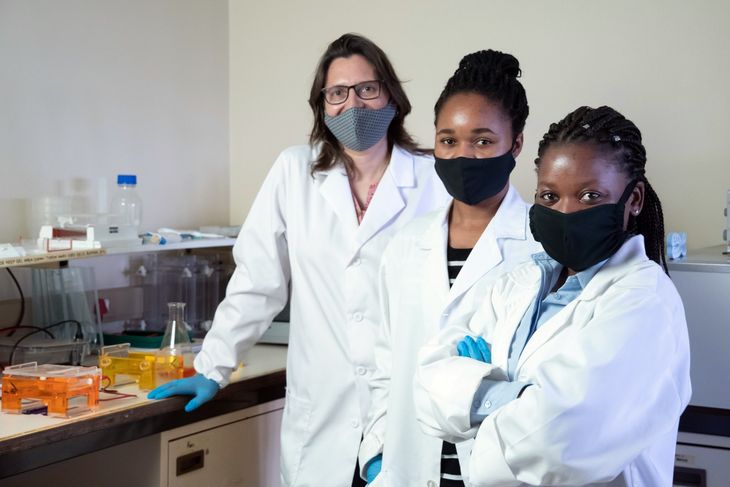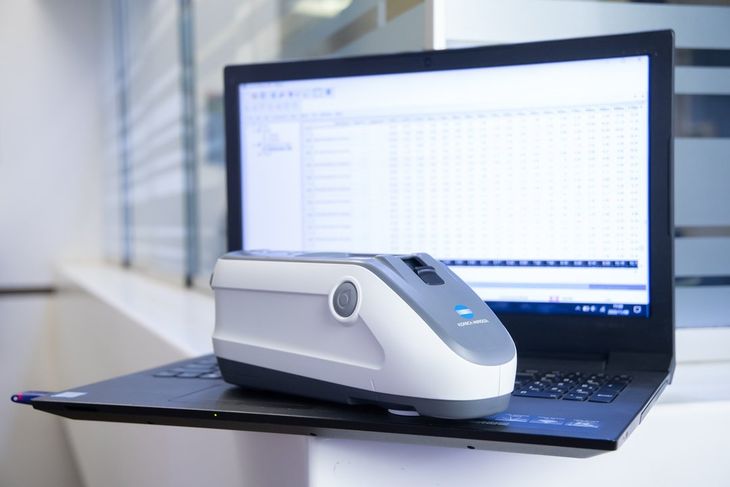HealthScan
is a non-invasive diagnostic platform allowing for differential, non-invasive, digital mass screening of infectious diseases, including COVID-19, Tuberculosis and Malaria.
Under development by Konica Minolta Austria in cooperation with the University of Pretoria.
HealthScan
HealthScan expects to provide a low-cost / high-throughput platform allowing for differential, non-invasive, digital mass screening for infectious diseases, including but not limited to COVID-19, Tuberculosis, Pneumonia, and Malaria. This will be done by enhancing currently commercially available devices for spectrophotometry and breath volatile sensing and linking them through data analytics. Reasoning algorithms are trained to combine the information about different biomarkers and calculate a risk for a person suffering from a certain disease.
With HealthScan, Konica Minolta intends to serve the growing need for rapid screening to enable customers to assess the risk of infection and the spread of infectious diseases.
... reading minimal changes of the skin color to detect COVID-19.
our insight of the week - November 20, 2020
Dr. Vinet Coetzee, with research assistants Audry Dube and Andani Ratshinanga (from left to right)
University of Pretoria. photo courtesy Mariki Uitenweerde / Eyescape
It is a curious thing that many smart inventions at face value seem so obvious. “My mother can immediately notice when I’m sick”, says Dr. Vinet Coetzee from the University of Pretoria, Faculty of Natural and Agricultural Sciences. “Because mothers are experts at using complexion to gauge health in their children. It is that kind of insight, unremarkable at first glance, that inspired the invention Konica Minolta Healthscan (hereinafter “Healthscan”). And it may fundamentally change the way we detect diseases on a global scale.
So far detecting diseases like Covid-19 has been quite a tough challenge. It takes medics and nurses, re-sources and patience. But there might be another way. Konica Minolta, Inc. a global digital technology company with core strengths in imaging and data analysis, optics, materials, and nano-fabrication and South African researchers are currently collaborating in the development of Healthscan, a platform for non-invasive, digital mass-screening of infectious diseases. They hope to make the detection of Covid-19, malaria, tuberculosis and many more diseases affordable, fast and easy to use for everybody.
The story of Healthscan began with the work of Vinet Coetzee. As a genetics researcher she sought to under-stand the ‘laws’ of human attraction. And one of the main roots she found was… health. People, for in-stance, gain insight into someone’s health status from the distribution of fat in his/her face. And good health is considered attractive. “I realized that we could actu-ally use what we’ve learned to help people”, Dr. Coetzee says. She started developing measures to screen children for nutrient deficiencies or Down syndrome using 3D cameras. One of her projects was looking at detailed skin color measurements and what it tells us about someone’s health. As she discovered, it tells us a lot.
Konica Minolta CM-26d spectrophotometer, photo courtesy company
Dr. Coetzee discovered that it is not only poor or good nutrition that can affect the color of our skin, but also the effect of infectious diseases. Studies in Nigeria, the Congo and South Africa showed that malaria infections can be detected accurately by using skin spectrophotometry. In industry, spectrophotometers are deployed by manufacturers in order to guarantee that colors remain consistent. Dr. Coetzee and her col-leagues simply apply them to a different use. For their malaria studies the researchers analyzed the color of the palm of the hand because it allows us to get in-sights not only into the skin color but also into the underlying blood coloration that changes when the body fights infection. Konica Minolta, i.a. an expert in the field of color measurement, helped to validate the results of the studies and joined Dr. Coetzee in the effort to detect even more diseases non-invasively. Together they are applying for funding to extend the range of diseases and the non-invasive measurements to detect these diseases, by combining the analysis of skin spectrophotometry and breath volatiles.
Non-invasive testing devices offer lots of advantages. They reduce the risk of infection. They can be used by everybody which may benefit rural areas that lack skilled personnel. They don’t need expensive infra-structure like cooling systems or imported resources which hinder testing in countries that cannot afford them. They deliver fast results. And since these results are digitalized, they may be shared in real-time with a global health surveillance network. This way, Healthscan devices at clinics, airports, borders and communities may provide real-time insight into regional outbreaks of infectious diseases.
Of course, this is still a long way off. There’s a lot more research and validation to be done. “The big thing that we need to do now is to develop an algorithm to identify these diseases accurately”, Dr. Coetzee says. “The IT structure in the background is quite a big component of the study.”
Although research in this field has only begun recently, there already is evidence that Healthscan may also help to detect Covid-19. Among other things the dis-ease reduces hemoglobin in the blood and increases its glucose level, both changes which might be detectable by the scanner. Dr. Coetzee hopes that breath analysis can also find volatiles that are specific to the disease.
In the future, Healthscan may prove useful for detecting Covid-19, malaria, tuberculosis, even diabetes. And it might also be helpful in detecting other diseases, Dr. Coetzee says. “To my knowledge, there's no other non-invasive device out there that can detect multiple diseases at the same time using the same device.”
November 20, 2020 by kENUP


